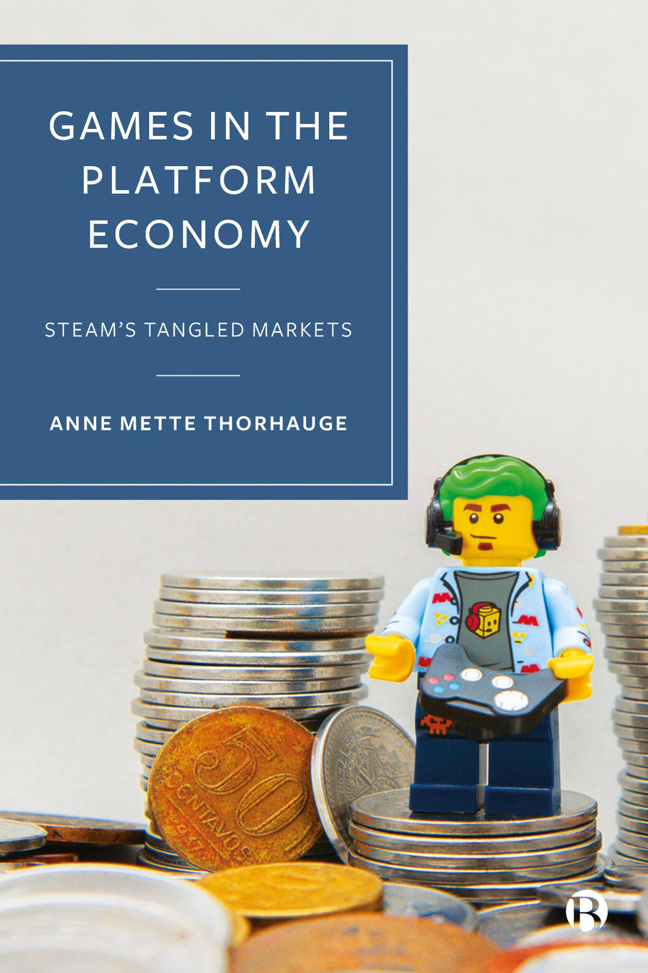Book contents
- Frontmatter
- Dedication
- Contents
- List of Figures and Table
- Acknowledgements
- 1 Introduction: Steam's Tangled Markets
- 2 Platform Configurations in Gaming
- 3 Economic Sociology and the Analysis of Platforms as Markets
- 4 Valve Corporation and the Steam Platform
- 5 Steam's Business Model
- 6 Shaping Market Interactions on the Steam Platform
- 7 Economic Actors on the Steam Platform
- 8 Player Trading beyond Steam
- 9 User Monetization and Value Creation in Tangled Markets
- Notes
- References
- Index
4 - Valve Corporation and the Steam Platform
Published online by Cambridge University Press: 23 January 2024
- Frontmatter
- Dedication
- Contents
- List of Figures and Table
- Acknowledgements
- 1 Introduction: Steam's Tangled Markets
- 2 Platform Configurations in Gaming
- 3 Economic Sociology and the Analysis of Platforms as Markets
- 4 Valve Corporation and the Steam Platform
- 5 Steam's Business Model
- 6 Shaping Market Interactions on the Steam Platform
- 7 Economic Actors on the Steam Platform
- 8 Player Trading beyond Steam
- 9 User Monetization and Value Creation in Tangled Markets
- Notes
- References
- Index
Summary
In the next four chapters, I will provide an empirically grounded analysis of the Steam platform as a particular type of game platform. I will do this because the Steam platform exhibits a distinct platform business model rooted in the economic features of games. Steam is, on one hand, comparable to other market platforms, with its focus on attracting game publishers and gamer communities into a multi-sided market controlled by the platform owner. On the other hand, it differs from other platforms in its active integration of player-driven economies at different levels of its platform design. This turns Steam into a direct illustration of the way platforms can be defined and analysed as ‘tangled markets’, extracting value at the intersection between different market contexts. In the following sections, I will firstly provide some historical context of Valve, the owner of Steam, and situate the Steam platform within the wider game market. After this, I will address how the Steam platform differs from other platforms and why this makes it an interesting case of ‘tangled markets’. I will use the key differences between Counter-Strike: Global Offensive and Fortnite to exemplify how this specific business model cuts across the game design, the platform, and economic practices beyond the platform (Thorhauge and Nielsen, 2021). Finally, I will briefly present the individual chapters of this analysis and their primary findings.
Valve Corporation: incumbent or challenger?
Valve was founded in 1996 by Gabe Logan Newell and Mike Harrington. Both were former employees of Microsoft and Valve's headquarters were physically located relatively close to the corporate headquarters of Microsoft in Redmond, Washington. At the outset, the company primarily focused on game development, and its first title, Half-Life, was a considerable commercial success. Mike Harrington left the company in 2000, however, and Gabe Newell took it in new directions. In 2003, the company reincorporated as Valve Corporation, moved its headquarters to Bellevue, Washington, and launched Steam as a game distribution platform. The development throughout the following two decades can be described as a gradual change of emphasis from game development to game services, involving the software and hardware solutions that undergird games. In addition to the Steam platform, these include the Steam Machine, the corporation's own series of gaming computers, VR headsets, and Steam Deck, a portable game system running on SteamOS.
- Type
- Chapter
- Information
- Games in the Platform EconomySteam's Tangled Markets, pp. 56 - 62Publisher: Bristol University PressPrint publication year: 2023

